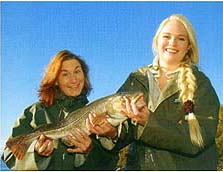 |
 |
Jarle Tryti Nordeide
Faculty of Fisheries and Natural Sciences, Bodø Regional
University, N-8049 Bodø, Norway. |
Photo by Lars Westvig
|
My research has since 1995 been concentrated on evolutionary behavioural
ecology of fish, including mating system, partner choice, acoustic communication,
spawning behaviour, and stock structure. Most of my work had been concentrated
on cod (Gadus morhua), although I have also studied partner choice of
threespine sticklebacks (Gasterosteus aculeatus).
There are at least two different major "groups" or sub-species
of cod along the coast of Norway, in the North-East Atlantic. The migrating
"Arctic" cod spend most of its life feeding in the Barents
Sea, but migrate southwards to the Lofoten Islands off at the Norwegian
coast to spawn. Eggs and larvae drift northwards along the coast into
the Barents Sea. The stationary "Coastal" cod spend its life
and spawn within fjords and coastal areas along the entire Norwegian
coast.
One of the major controversies among Norwegian scientists during several
decades has been whether Arctic and Coastal cod interbreed. Ivar H.
Pettersen and I found a much more uniform population structure of cod
south compared to the north of the Lofoten Islands. This result supports
the majority of papers which have concluded that Arctic and Coastal
cod belong to two different groups or sub-species.
I then caught spawning cod at major spawning grounds off the Lofoten
Islands, and found ripe individuals of both groups being present at
the same grounds simultaneously.
This raises the interesting question how individuals of the two groups
avoid interbreeding, since several recent papers and a recent textbook

have described cod mating system as "promiscuous"
without active partner choice. In cooperation with Ivar Folstad, I therefore
suggested, based on a review of the literature of cod spawning behaviour,
that female cod actively choose partners and that a "lek"
mating system best describes the mating system of cod.
Cod communicate acoustically, especially during the spawning season
and Professor Dag Møller suggested in 1968 that the two cod groups
avoid interbreeding because their spawning behaviour, and especially
their acoustic calls, differ. To test this hypothesis, Erling Kjellsby
and I went out to the major spawning grounds off the Lofoten Islands
to record the calls from spawning cod. The recordings revealed a hushed
hubbub produced by what we argue most likely is spawning Arctic cod.
Moreover, recordings from another fjord in northern Norway, where coastal
cod spawn, showed a rumble of sound at a slightly different frequency.
Jens Finstad and I then captured both groups of cod, kept then in different
tanks, and recorded and compared their grunts. We revealed large variance
between the grunts, which is expected if females’ choose males
from their calls. However, we have so far not been able to tell apart
grunts of the Arctic and Coastal cod.
Our plans for the near future is to analyse and compare the grunts from
the two groups with less rough tools. Moreover, Espen Søreng
is at the moment doing his Master thesis by artificially crossing Arctic
and Coastal cod, and comparing fitness parameters of hybrid and non-hybrid
eggs and larvae.
Return to Top |Research
Programs
|


